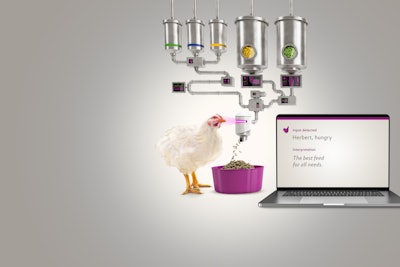
We face a global challenge in feeding a rapidly increasing population, while using fewer resources to do it. In short, we need to do more with less if we are to successfully and sustainably feed the 8 billion people predicted to live on the planet by 2025. This sustainable global food challenge will take a variety of players and approaches to resolve, but technology will undoubtedly be central if we are to be successful.
Digitization, the Internet of Things and more powerful software all offer tremendous new opportunities to change the way we produce our food. However, it takes more than just technology. It also requires a profound know-how of the domain in question and expertise in livestock farming to utilize the data and bring value to the entire production cycle.
Implementing a new approach to poultry production
That’s why at Evonik we’re implementing a ‘Precision Livestock Farming’ (PLF) approach for poultry production. By combining our decades of science-based expertize with intelligent software algorithms and consistent connectivity, it is possible to interlink previously disconnected areas of the production process.
We’ve already created products like essential amino acids with highest bioefficacy for maximum animal performance, analytical services using NIR technology and nutritional tools to optimize animal feed with a long track record. Lately pathogen screening, big data software and gut health products were added to the portfolio. PLF is the next natural step to expand and optimize the offering that helps to ‘science the global food challenge’.
Based in existing practices
PLF may like sound like an overly technical approach to producing poultry, but it is rooted in three very straightforward practices already in place across the world: animal nutrition, animal health and animal farming.
Combining these three approaches allows producers to maximize the positive impacts of their actions and to sustainably improve both animal welfare and outcomes. It is about having a better understanding of the entire production process and ensuring everything is working in the best way.
- Animal nutrition
Feed costs can make up to 70% of poultry production costs and feed quality significantly influences meat yield and meat quality. Precise analysis of nutritional values in the feed ingredients enables the best possible use of feed ingredients, improves feed quality, ensures animal health, and reduces environmental impact.
- Animal health
Frequent screening for pathogens in feed and faeces provides an ongoing reflection of a flock’s health status. Ongoing environmental monitoring can reduce the use of antibiotics. Controlled actions help to improve animal welfare and to increase the yield per flock.
- Animal farming
Collecting, processing, and analyzing data generates information that experts can transform into knowledge. This newly gained knowledge about biostatistics and machine learning leads to a deeper understanding of the production process, enables producers to better predict and make the right business decisions, and helps to find the best balance of production costs and product quality.
Bringing these elements together offers the best chance for producers to meet the needs of their customers, sustainably and profitably. The journey has already begun.
Johann Fickler, Vice President, Precision Livestock Farming at Evonik











